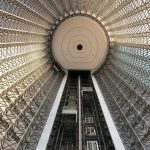THE FUTURE OF METRO STATIONS
In March 2015, London reached a record population of 8.6 million inhabitants (Brexit). In the next eight years, this figure is expected to reach nearly 10 million1.
For some 150 years, the London Underground network has been an integral part of the city: it is the world’s oldest underground transport network. Today some 1.34 billion passengers (plus 33% over the past decade) use the “Tube” every year. This figure increased by +3.2% in respect to previous period. Today, the London Underground is already facing a difficult task as “its metro stations are feeling the strain from the rapidly increasing commuter numbers”.
Then, moving people around transport networks easily and effectively is not an easy task. Metro stations are complex infrastructures that connect several rail lines overlapped in a very restricted space. The capital’s busiest tube station, London Waterloo, handles 95 million passengers every year (to give an idea: this is more or less the population of the entire Philippines) and the deepest platform in the network is 58 meters below street level, at Hampstead. Commuting time and passenger comfort should be at the forefront of all considerations for re-designing these metro and railway stations to ensure they can accommodate the needs of the modern-day traveler.
As people’s lifestyles evolve and commuters seek to achieve a better work/life balance, transport hubs are also increasingly being developed into retail and dining locations; places people want to stay, rather than leave quickly. As seen so clearly in stations such as Waterloo and King’s Cross, metro hubs are now centers of human interaction, where people can enjoy a comfortable environment for commuting and leisure activities alike. So, as urbanization won’t slow down, the operational feasibility of the city’s key services are facing a difficult task.
In November 2014,ThyssenKrupp launched Multi, and, one year later, they presented the first running prototype (scale model). It is a landmark revolution in the vertical transportation industry and a new and efficient transport solution for high-rise buildings. The long-pursued dream of operating multiple cabins in the same lift shaft is made possible, by applying the linear motor technology of the magnetic levitation train Transrapid to the lift industry.
On 7 June 2016, some thought-leaders gathered in London (UK), in a panel debate to discuss the latest technology set to transform metro stations and bring them in line with 21st century demands. The participants were: Lauren Sager Weinstein (head of analytics & customer experience, TfL – Transports for London); Baroness Jo Valentine (CEO, London First); Rachel Skinner (smart cities experts and director of development, WSP Parson Brinckerhoff); Andreas Schierenbeck (CEO, Thyssenkrupp Elevator) and Chris Williamson (partner at Weston Williamson + Partners). Mark Hansford (editor of “New Civil Engineering”) moderated the debate.
The starting point was that with population growth and urbanization driving more people to cities than ever before, metro stations – which are the beating heart of city life, transporting people from home to work and other daily destinations – are facing unprecedented challenges to mobility and efficiency. In London alone, the population is growing at a rate of 1.5% year-on-year. Probably these figures will have to be reconsidered following Brexit, but the expected growth will still be impressive. Then, implementing new technology at key city transport hubs is essential to get people from one place to another, as effectively as possible.
Lauren Sager Weinstein (head of analytics & customer experience, TfL – Transports for London) said that “we need new ideas to develop future plans”. She stated that tube stations are a complicated environment, nevertheless as technology has changed so rapidly and dramatically, in the last few years “it might be tough and it has some risks involved, but we have to embrace innovation”. In her opinion, the future of connectivity in large urban areas passes through new concepts “to create more livable spaces through new mobility systems”.
In the debate, Baroness Jo Valentine was the voice of “London First”, a not for profit organization, composed of leaders of businesses in London, whose aim is to “make London the best city in the world in which to do business”. The CEO of London First said that London has the oldest underground system in the world and one of the largest in the world. “The Tube serves a high density populated metropolitan area. It serves a growing city, in terms of population, services, tourism and transport systems. What we are facing today, is the challenging and most complicate cacophony of transportation. So we need fresh ideas and ‘horizontal lifts’ might be a solution”.
Your reporter personally experienced the real mess in London urban mobility: my taxi was stuck in immobile traffic jams, as trying to reach the Tube to get my train to the airport. The taxi driver was so sorry, following many different attempts to avoid being stuck, that he applied me a good discount on my fare.
Rachel Skinner is a smart cities expert and the UK director of marketing & communication at WSP Parson Brinckerhoff Engineering Services. She is also the current president of the London Women’s Transportation Seminar. “Somehow, we live in cities as angry bees. In the next decade, we need to make cities work better. So how to design buildings for the future? The answer is to create livable places and new mobility systems through new technologies. But we need also to have a synergic evolution of the whole system: no stand-alone solutions, not only an iconic approach”.
Chris Williamson, Weston Williamson + Partners declared: “The original submerging of train lines underground was absolutely revolutionary for its time, but as passenger demand continues to rise it is unsurprising that the sub-ground location of these lines make it incredibly difficult for developers to bring them up-to-date with modern capacity and access requirements. For most commuters it is equally as important to swiftly and comfortably access the deepest platform as it is to move quickly from station A to B”. Now, in his opinion, rope-less lift technology, like the Multi system has the potential to redefine existing infrastructure, and open up unprecedented levels of access both in-between platforms, and from the platforms to the world above. “This kind of innovation is key for future city design and could provide a game-changing solution to solve the mobility issues that so many underground networks now face. What’s more – it could also allow further growth of stations below the ground, making it possible to build new train lines underneath the existing ones, to increase capacity even further”.
Andreas Schierenbeck, CEO at Thyssenkrupp Elevator explained that Multi was initially developed for tall buildings, to double lift shaft capacity, reduce lift footprint, and offer vertical and horizontal movement to enable architects to construct taller, more creative and more user friendly structures, such as the sky bridges. “Its concept makes it a prime solution to the challenges of metro stations as well. If applied it would undoubtedly change the face of London’s transport network. Yet it also offers a practical solution that could ease congestion in dozens of underground networks across the world too; a thought that makes you realize its potential to be one of the most revolutionary new developments of our time”.
In a later interview (urban-hub.com), Chris Williamson said that in subways, Multi “significantly increases handling capacity and reduces the waiting time for lifts: it will be possible for many more people to use lifts instead of the escalators. When stations reduce dependency on escalators, it will be easier to build stations. Less land at street level is required for station construction and it, therefore, becomes easier to position the station exactly where people want to arrive”. He then explained that “it is often impossible to build a new metro line through a complex underground network. But it will be possible to build a new line below it, if it’s served by lifts. At 58.5 m below ground, Hampstead station is the deepest station in London. Still this is not enough for lines to run below the pile foundations of tall buildings, which can even reach depths of 100 meters. With the speed and handling capacity of Multi, stations could easily exist at much greater depths than what is currently possible with escalators”.
By Fabio Liberali










